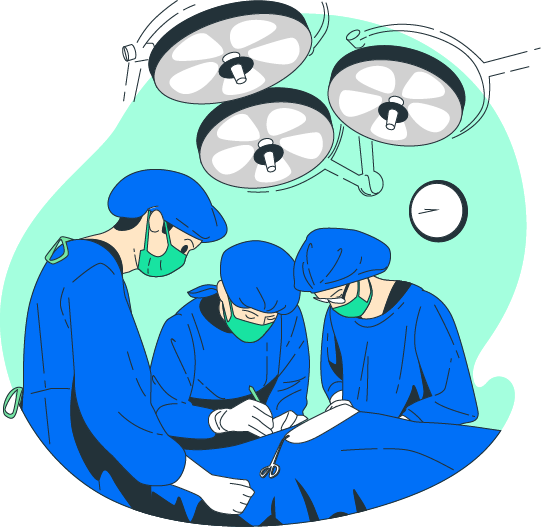Chronic pain often leads patients down the road to surgical intervention. These surgeries typically come with a 0, 10, or 90-day global period, a critical window where providers must navigate restrictions on billing for additional services. This global period encapsulates the full spectrum of care: preoperative assessments, the procedure itself, and postoperative recovery.

Table of Contents
Understanding Global Procedures
A global procedure refers to a specific time frame during which a provider is unable to bill separately for routine services linked to a surgery.
These global surgical packages bundle everything; from pre-surgical preparations to intraoperative work and postoperative follow-ups.

Global Surgery Indicators
Medicare, the gold standard for healthcare reimbursement, has established payment rules for global procedures known as global surgery indicators, with most private insurers mirroring these guidelines. However, identifying the global period for a procedure can sometimes feel like decoding a secret language.
Here’s the breakdown:
- 000 – Zero-Day Postoperative Period: For minor surgical procedures requiring no post-op follow-up beyond the same day.
- 010 – 10-Day Postoperative Period: For other minor surgeries with a brief recovery phase.
- 090 – 90-Day Postoperative Period: Reserved for major surgeries with extended post-op care.
- YYY – Contractor-Priced Codes: When no standard exists, Medicare contractors define the global period. Not all contractor-priced codes carry a YYY indicator, making it essential to review case by case.
For precise details, practitioners can always refer to the Medicare fee schedule to verify specific codes and their associated global days.
Understanding these indicators empowers providers to streamline billing, avoid costly denials, and maintain compliance with payer guidelines.
Modifier Usage and Descriptions
Modifiers are the unsung heroes of medical coding, small but powerful tools that add critical details about a procedure, service, or supply without altering the core meaning of the code. They help clarify pricing, payment adjustments, and procedural locations, ensuring billing accuracy and maximizing reimbursements.
Modifiers are categorized into three key types:
- Pricing Modifiers: Like TC (technical component) and 26 (professional component) are examples of pricing modifiers that provide additional details about the nature of the service rendered.
- Payment Modifiers: Affect how claims are processed and reimbursed Such as 50 (bilateral procedure) and 59 (distinct procedural service).
- Location Modifiers: Including RT (right side) and LT (left side).
In chronic care coding, proper modifier use can mean the difference between full reimbursement or costly denials. Some procedures have strict guidelines for when modifiers apply, while others allow multiple modifiers for the same service.
Let’s break down Modifier 50, a frequent player in bilateral procedures.
Modifier 50 (Bilateral Coding)

Modifier 50 signals that a procedure was performed on both sides of the body. This is crucial for bilateral services, ensuring coders avoid duplicate charges while still capturing the complexity of the procedure.
Medicare has outlined clear bilateral surgery indicators to guide when and how Modifier 50 should be used. These rules are accessible on the physician fee schedule and offer a roadmap to prevent coding errors.
Bilateral Indicators
Here’s a quick guide to bilateral indicators and how they affect billing:
Indicator 0 (Modifier 50 Not Allowed) | Bilateral rules do not apply. Even if the procedure is done on both sides, Modifier 50 cannot be used. Example: Evaluation and management of an established patient (99214). Modifier 50 would not apply. |
Indicator 1 (Bilateral Rules Apply) | If the procedure is performed on both sides, Modifier 50 is used with 1 unit. Medicare may reimburse at 150% of the single procedure rate. Example: Impaction removal from both ears (69210). |
Indicator 2 (Procedure Already Priced as Bilateral) | Bilateral pricing is built into the code description. Modifier 50 should not be added. Example: Bilateral pelvic osteotomy (already defined as bilateral). |
Indicator 3 Special Bilateral Rules (Radiology Focus) | For certain procedures, bilateral rules differ. Modifier 50, LT, or RT may be used with 2 units. Medicare reimburses at 100% of the allowed amount. Example: Radiologic examination of the wrist – 2 views (73100). |
Indicator 9 (Bilateral Concept Does Not Apply) | Modifier 50 cannot be used as the bilateral concept is not relevant. |
By mastering Modifier 50 and similar tools, you’re not just coding – you’re ensuring the financial health of your practice.
Inappropriate use of Modifier 50
Modifiers are essential tools in the coder’s arsenal, but when used incorrectly, they can lead to claim rejections, audits, and even financial penalties. Knowing when not to use modifiers is just as important as understanding their proper application.
Modifier LT and RT
Modifiers LT (Left Side) and RT (Right Side) are less complex than Modifier 50. They serve a descriptive purpose by identifying the side of the body where a procedure was performed. While they do not directly impact payment, they provide essential details that can support accurate reimbursement.

When to Use Modifier LT or RT
Modifiers LT or RT are typically used for unilateral procedures to specify the side of the body involved.
Example:
27560-RT | Closed treatment of patellar dislocation, right side. |
In some cases, payers may require LT and RT on separate lines instead of Modifier 50 for bilateral services. Check with the payer’s guidelines to confirm how they prefer the modifier to be applied. Payer requirements can vary, so staying informed is essential to avoid denials.
Modifier 59
A Commonly Misused Power Tool
Modifier 59 is one of the most frequently used (and misused) modifiers in medical coding. It identifies a procedure or service that is separate and distinct from others performed on the same day by the same provider. However, it should not be used if another, more appropriate modifier exists.
Many coders mistakenly apply Modifier 59 in scenarios that do not meet the criteria for separate procedures, resulting in unnecessary denials.
Modifier 59 Subsets
Due to frequent misuse, Medicare introduced more granular modifiers to replace 59 in certain cases. Many private payers have adopted this system.
- XE: Distinct service due to a separate encounter.
- XS: Procedure performed on a separate organ or structure.
- XP: Procedure done by a different practitioner.
- XU: Service unrelated or non-overlapping with the primary procedure. (sometimes used in place of modifier 59)
Example: If a biopsy is performed on the left breast and a separate excision is conducted on the right, XS or XU may apply.
Inappropriate use of Modifier 59

Avoid using Modifier 59 or XU simply because two codes have different descriptions.
- Do not report two codes together if they reflect procedures performed at the same site during the same encounter.
- Modifier 59 or XU should never bypass a Procedure-to-Procedure (PTP) edit just because the codes differ.
Evaluation and Management Modifiers
Certain modifiers are exclusively used for Evaluation and Management (E/M) codes. These help coders distinguish between services and prevent bundling issues.
- Modifier 24: Unrelated E/M service provided during a postoperative period.
- Modifier 25: Separately identifiable E/M service on the same day as another procedure.
- Modifier 57: Used when an E/M visit leads to the decision for surgery, typically within 24-48 hours of the visit.
Example:
A patient experiencing worsening knee pain sees a provider who decides during the visit to proceed with surgery. Modifier 57 is appended to indicate that the decision for surgery was made during the E/M visit.
Consequences of Using Modifiers Incorrectly
Proper modifier application is crucial to maintaining coding integrity. Using modifiers incorrectly to maximize reimbursements or bypass edits can trigger audits and lead to severe penalties.
- Incorrect modifier usage can result in disciplinary actions, repayment demands, or even fines amounting to thousands of dollars per claim.
- Persistent misuse may flag your practice for prepayment reviews or payer audits.

To safeguard your revenue and reputation, always ensure modifiers are used appropriately and are supported by clear documentation.
What are NCCI (National Correct Coding Initiative Edits)
The National Correct Coding Initiative (NCCI) Edits were developed by Medicare to prevent improper payments for services that shouldn’t be billed together. These edits ensure coding accuracy by flagging combinations that are considered mutually exclusive. These edits consist of two columns, column 1 and column 2. Reimbursement will only be given for column 1 code.
In some instances, a modifier can be used to specify two distinct services. In this case, a modifier can be used to distinguish a separate procedure was performed. An example of this would be codes 29827 and 29820, a modifier would be able to bypass this edit if documentation supports the use of it. In other instances, there are no modifiers that can bypass the edit.
| MUE Edits | Another type of edit is an MUE edit. These edits occur when claims have too many of the same services for the same date. Not all CPT’s have an MUE limit. |
What are NCDs and LCDs
Medicare relies on coverage policies to decide which services are eligible for payment. These policies are created through evidence-based research and fall into two categories:
NCD (National Coverage Determination):
- Established by Medicare at the national level, NCDs apply uniformly across all Medicare Administrative Contractors (MACs).
- NCDs are based on clinical findings, treatment protocols, and best practices.
LCD (Local Coverage Determination):
- LCDs are developed by individual MACs and are region-specific.
- A procedure or service covered in one state may not be covered in another.
Providers can search for both LCDs and NCDs through the Medical coverage database to stay informed about current and changing coverage policies.
Tips on Coding
Staying informed and organized is essential for accurate coding and maximizing reimbursements. Here are a few practical tips to enhance your coding skills:
Stay Current on Coding Guidelines:
- Attend coding seminars, workshops, and online training through AHIMA or AAPC. Keeping up with CPT updates and policy changes ensures that your practice complies with evolving standards.
Review Provider Documentation:
- Accurate and complete documentation is the cornerstone of correct coding. If medical records are incomplete or unclear, query the provider for clarification to ensure all billable services are properly recorded.
Capture All Codes for Every Encounter:
- Failing to report even minor services can reduce reimbursements. Conduct thorough reviews to ensure all services, procedures, and diagnoses are captured during each patient encounter.
These steps help coders reduce errors, minimize denials, and contribute to smoother billing processes for healthcare organizations.
Accuracy and Maximize Revenue with Neolytix’s Comprehensive Services
Medical coding and billing for global procedures and modifier usage isn’t just complex, it’s a constantly evolving landscape with strict guidelines outlined in the AMA CPT codebook. Even the smallest oversight can lead to claim denials, revenue loss, or compliance issues.
At Neolytix, we understand the challenges healthcare practices face. Our team of certified billing and coding experts is here to help you streamline your processes, minimize denials, and maximize revenue.
When accuracy, efficiency, and compliance matter most, trust Neolytix to deliver:
- 100% HIPAA-compliant billing services tailored to your specialty.
- Fast and efficient credentialing backed by proven workflows.
- Comprehensive revenue cycle management that drives results.
Need expert support?
Contact Neolytix today to explore how our billing, coding, and credentialing services can help your practice thrive in 2025.
Let us handle the complexities so you can focus on what matters most – delivering exceptional patient care.
Get Help with Billing, Credentialing, & Virtual Assistants - Work With A Team of Experts
"*" indicates required fields



